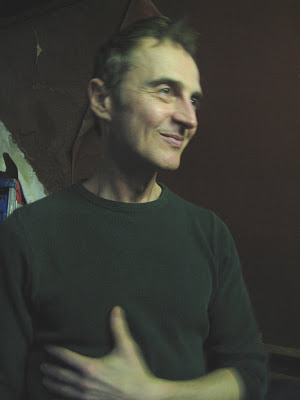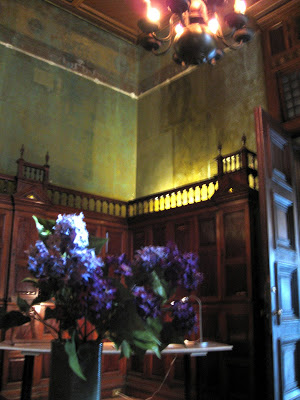music
Art Vent Letting the Fresh Air In
I haven’t been to India, but I have been to Egypt, where the soft pastels of the clothing and painted clay houses, the graceful sails of the feluccas on the Nile, were one with the sandy, palm-treed landscape, each vista more breathtaking than the last, every aspect harmonious. The way the shopkeepers in the Aswan market laid out their wares was as artful as any installation I’d ever seen. Beauty seemed as natural as breathing.
And beauty, I’m convinced, is as necessary to healthy life as clean air, water, and food, yet we in the West pretend that it’s a luxury. The only way we acknowledge beauty’s importance is by punishing criminals by depriving them of it. Prison wouldn’t be prison if cells had brightly colored walls and inmates wore attractive uniforms— “Jil Sander for Attica" would not fly.
Even the environments we create for people to live and work in (and supposedly get well in, just look at our hospitals—we won’t even speak of the food) are equally aesthetically barren. Every time I drive through mall heaven in the towns outside Boston, or on Long Island or…anywhere, I go into shock.
So back at the piers, there’s an inescapable irony in paying $30 to look at art—try to find beauty—in the most inhospitable of situations: crowded, hot, claustrophobic, everything squished in. Another friend says she likes Ikea better—“at least they give you a green line to follow.”
 From the Armory Show: Keltie Ferris, He-She, 2010, oil, acrylic, oil pastel & sprayed paint on canvas, 80x60"
From the Armory Show: Keltie Ferris, He-She, 2010, oil, acrylic, oil pastel & sprayed paint on canvas, 80x60"
Courtesy Horton Gallery, New York. Photo: Mark Woods
Meanwhile, a real armory on Park Avenue, intended for storing military equipment and built at a time (1861) when beauty was still a priority, makes a much better backdrop for art, which is why I prefer the ADAA (Art Dealers Association of America) Art Show, this year concurrent with the ones at the piers. Not edgy, you say? Okay with me. At least I can breathe.
…and visit with John Kelly, who’s artist-in-residence in this lavishly decorated monument to war that’s being turned into an alternative art space. Dancer, singer, actor, writer, painter (my review of his recent show at Alexander Gray was in the November Art in America), John is one of the most charismatic performers ever, the proof being that he can make even cabaret (a musical genre I loathe, right up there with musical theater) into a thrilling experience. I’m such a fan! John will be channeling Joni Mitchell in performance in Usdan Gallery at Bennington College at 9:00 this Friday evening. John Kelly
John Kelly
 The Armory Studio
The Armory Studio
My desire for sound and light, however, was more than satisfied the next night, when I bought a single ticket to hear Muse and the Silversun Pickups (who you must know by now are my favorite band) at that most unaesthetic of venues, Madison Square Garden. No doubt the show cost a gazillion dollars and took months to prepare—and Muse is definitely OTT, no subtlety there—but I was primed. It wasn’t Art, so they had to deliver. At the end I was getting hugs from sweaty, 20-year-old guys (“You like Muse? Let me give you a hug!). Totally worth it
Bat for Lashes's recent "Daniel" is high on my mix, but her video of a couple of years ago, "What's a Girl to Do," which my friend, Catherine played for me the other day, has to be one of the best. Unfortunately "they" (whoever they are) won't let me embed it, but you can find it here.
So I’ve been happily dancing and singing along in the kitchen tonight, preparing my wild rice contribution to my friends’ annual pot luck, and hope everyone has a thankful Thanksgiving.
I can also tell you that their father and I brought two sons into functioning adulthood without any of that crap—and it’s something they’ve continually thanked us for.
Although Matt's the music professional, my most vivid early memories of my children and music have to do with his younger brother, Adam, probably because of the dark winter when Adam was two and had pneumonia, which meant long weeks inside with just mom and the stereo. He spent hours dancing to the Beatles in front of the speakers, identifying which side of the album he wanted to hear by pointing to the cut or whole apple illustrated on the label. Among his other favorites were Bob Marley's “I shot the sheriff but I didn’t shoot the dead tree” and Paul McCartney’s “Man on the Rug." I remember trying to tear him away from Elton John’s "Goodbye Yellow Brick Road" when we were late for a doctor appointment, by promising that we’d listen to the radio in the car. He was screaming “Yellow Brick Road! Yellow Brick Road!” as I carried him out and once in the car, insisted on hearing it there. I tried to explain that the radio played what it wanted, not what we wanted, but lost all credibility when I turned it on to find it playing—of course—“Yellow Brick Road.”
This all comes to mind as I’ve recently been spending much delightful time with various friends’ toddlers, loving the way 1-4 year olds are so trustingly imitative while remaining true to their emerging personalities—a combination that’s often hilarious. Then this morning Cary Smith sent me the link to this video of Thom Yorke singing the Radiohead classic “Weird Fishes” with orchestra (wait for the sound to start)…
…after which I found this, and it cracks me up:
Don't skip over the song links to the music videos above, each one better than the next, ending with Elton John accompanied by Muppets, the Sesame Street album being a big exception to my rule—because I enjoyed it. Happy parents, I always think, make for happy children. And why not give them something that enriches not only their present, but future life?
 Arthur Dove, Me and the Moon, 1937, wax and emulsion on canvas, 18 x 26", Phillips Collection, Washington, D.C.
Arthur Dove, Me and the Moon, 1937, wax and emulsion on canvas, 18 x 26", Phillips Collection, Washington, D.C.…the hallmark of great art is generosity (the artists themselves may be self-involved sonsofbitches), but the work has to give something, make a vital connection with the souls of others….
And from Brian:
When a pianist is about to sit down and play Clair de Lune in concert, someone with a microphone doesn’t first come out on the stage and explain that Debussy was known as an Impressionist, that this work, the translation for which is “Moonlight,” may have been based on a poem of the same name by Paul Verlaine, and that the arpeggios were meant to convey the “impression” of moonbeams illuminating a garden.
Although Debussy’s intention was to suggest moonlight, what if you, the listener, are inclined to think of waves of water, or silk rippling in the wind, or the music evokes an emotion or sensation you feel inside your body, or reminds you of a dream? Are these responses not valid? And would you be more or less likely to think of other ways of interpreting the music, once you’ve been told what it’s supposed to be about?
Also, why do we want to hear this piece again and again? Is it because Debussy was important in providing a link between romanticism and modern music, and the composer happened to be successful in his intention of making music that sounds like moonlight—or because it’s an exceptionally beautiful and expressive piece?
With music, any information about the artist and his/her intention is not an element in the performance but is available—or not—in the program; there’s no assumption that it’s essential to the enjoyment of the music. Why should visual art be any different? When placed on the same plane as the art itself, explanatory text assumes authority, becomes part of the experience, and narrows the lens through which it will be viewed.
[Actually, where Glass seemed to take no notice of his surroundings, Ginsberg’s interest was unnerving as he went around my kitchen and living area examining absolutely everything—I was glad I cleaned up before he came—picking up each object, turning it over, asking “What’s this? Where’d you get it? What do you do with it?” And, after a while, “Are these your paintings?”
“Yes.”
“Weird.”
When I told him I was a Nuyorican poet (meaning I performed regularly at the Nuyorican Poets Cafe) Ginsberg said, sweetly, “Me too.”]
In the film about Glass, amidst a few snippets of music, we see shots of the composer making pizza, playing with his small children, practicing T’ai Chi with his teacher (who was a fellow student in the classes I took for many years with Master Ham King Koo) while various friends, family members, and colleagues weigh in with remembrances. Having just returned from my first experience with film editing, I’m hyper aware of what’s essential and what isn’t—such as the shot of his houseguest taking out the garbage, or the part where his wife reveals her Internet password, a bit that’s kinda cute but tells us nothing.
The second evening featured Glass in person, in an interview with a film critic who’d chosen a number of cuts from films for which Glass had written the score, asking him to comment on each one. And guess what? Glass was totally interesting, probably because he was talking about making music, which Hicks, when he brings it up at all, treats it as a product rather than a process (never touching on the things I wanted to know, such as, what was the first piece Glass composed? Did his early study of mathematics have an effect on the kind of music he makes? When he works, does he noodle around on the piano or does he hear it in his head first? What does he learn from hearing his work performed by others? What did he get from his classical studies, from the work of John Cage, Ravi Shankar?). But here, listening to Glass discuss his concepts for each film we got an idea of how his mind works, his fascination with the art of filmmaking, how he wants the score to be an integral part of the process rather than something tacked on in post-production. For Godfrey Reggio’s Powaqqatsi (1988), Glass went with the director to Brazil to document fortune seekers mining for gold, the cinematographers listened to his music as they shot the footage, and the childlike nature of the of the very young gold-diggers Glass met inspired him to later add a children’s choir to the score…all of which is so much more interesting than pizza (my impression of him as a phonoholic stands, however, because at one point onstage he did actually check his cell and may even have been texting).
To round out the evening Glass played several pieces—his encore was from the early (1970) Music with Changing Parts, one of my favorites—and as we drove home, while I hadn’t completely forgotten about my frozen pipes, I didn't care so much.
For a documentary that successfully delves into the heart and soul of a musician, do your best to catch Steven Sebring’s Patti Smith: Dream of Life (schedule)--also available on NetFlix:
 Roberto's windows, December 2008
Roberto's windows, December 2008